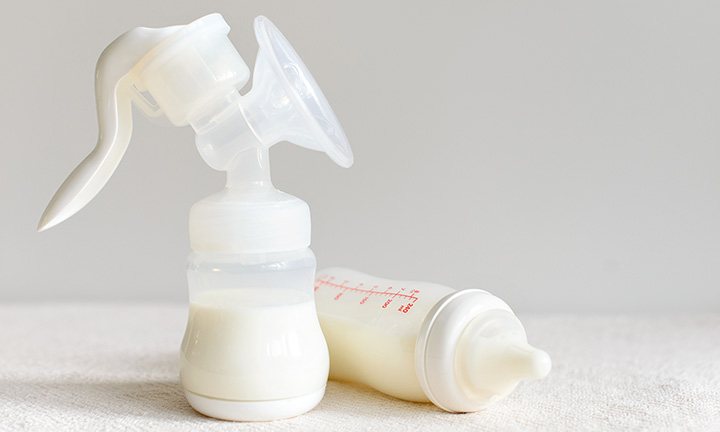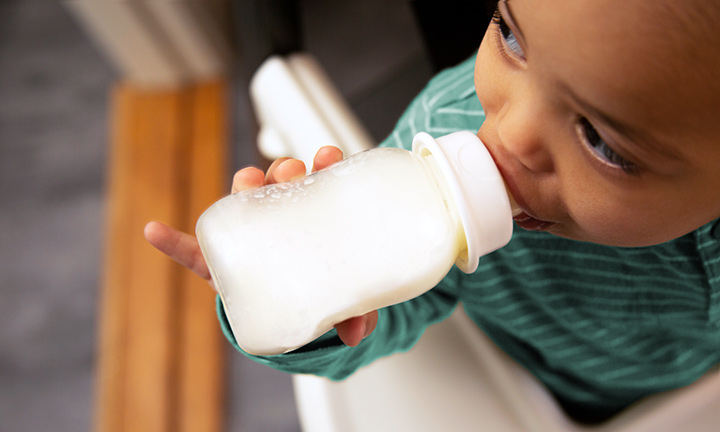
Breastfeeding Tips to Support Your Journey
Breastfeeding can be rewarding, but it often comes with questions, especially in the beginning. Whether you're just getting started or looking to improve your routine, a few practical breastfeeding tips can help make the experience smoother and more comfortable.
Many new parents wonder about the right breastfeeding position for a newborn, how to improve milk supply, or what to do if feeding becomes painful. Feeding on demand, staying hydrated, and asking for help when you need it are all important pieces of the puzzle.
Here's a quick overview of what can help:
Understanding these basics can help you feel more prepared, supported, and at ease. In the sections ahead, we’ll explore essential tips for breastfeeding, go over helpful tools, and offer guidance for common challenges, so you and your baby can thrive together.
The Benefits of Breastfeeding
Breastfeeding offers numerous well-documented benefits for both your baby and you, the parent. While every family’s feeding journey is unique, here are some key reasons many parents choose to breastfeed:
If you decide that breastfeeding is the right path for you, exploring a few breastfeeding tips, finding the correct breastfeeding position for you and your baby, and seeking guidance from your healthcare provider or a lactation consultant can help you get started with more confidence.
That said, not every parent is able or chooses to breastfeed—and that’s okay. Formula feeding also offers bonding opportunities and important nourishment. The most important thing is that your baby is loved, fed, and supported.
If you’re still navigating other parts of early parenthood, like wondering “when will mood swings start in pregnancy” or adjusting to life with a newborn, know that every stage comes with its own learning curve. Take your time and seek support when you need it.
Breastfeeding Positions
Here are some common infant breastfeeding positions you can try with your baby. Testing them out can help you discover which ones allow your baby to latch more effectively while keeping both of you comfortable and relaxed. Finding the right position for breastfeeding may take some trial and error, and that’s completely normal.
Twin Feeding Positions:
These breastfeeding positions can be adjusted depending on your comfort, your baby's latch, and your recovery. Try different breastfeeding positions for newborns until you find the ones that work best for both of you.
Other Breastfeeding Tips
So, aside from trying out various positions, what helps with breastfeeding? While every journey is different, there are a few key ideas that can make a real difference, especially in the early days.
The following breastfeeding advice for new parents includes some tried-and-true breastfeeding tips that may help things go more smoothly, whether you’re nursing for the first time or navigating new challenges. From preparing ahead of time to finding support and staying comfortable, these tips and tricks for breastfeeding are all about helping you feel more confident and supported.
And remember, there are no perfect rules; successful breastfeeding looks a little different for every family. Consider these suggestions and see what feels right for you and your baby.
You’ve got this.
1. Attend Breastfeeding Classes
It’s a good idea to get some information and instruction on how to breastfeed while you’re still pregnant, especially if you’re a first-time parent (or if it’s been a while since you’ve breastfed). Research shows that those who learn about breastfeeding during pregnancy are more likely to have successful breastfeeding experiences than those who do not.
Breastfeeding classes may be offered at a local community center or hospital. Your healthcare provider can help you find a class or arrange a one-on-one session with a lactation consultant for more personalized breastfeeding advice for new parents.
2. Gather the Essential Nursing Supplies
Anything that can help make your life simpler and more comfortable while you breastfeed your baby is a welcome addition. Here are some things to consider buying:
3. Let Your Healthcare Provider Know You Plan to Breastfeed
It’s a good idea to tell your healthcare provider during pregnancy that you’d like to breastfeed your baby. That way, your provider can ensure you have the necessary information and resources. If you’re putting together a birth plan, you can include your wishes about breastfeeding in that document and also remind your healthcare team about your plans when you're admitted to the hospital to give birth.
If you're taking any medications, your healthcare provider should know that you're planning to breastfeed. In some cases, your provider may recommend adjustments to ensure they’re safe for nursing. This step is one of the breastfeeding dos and don'ts that can help protect both you and your little one.
4. Breastfeed Right After Birth
It’s beneficial to breastfeed your little one very soon after they’re born if possible. Newborns are typically ready to nurse within the first hour after birth.
Those first feeds nourish your baby, of course, and get you both started in figuring out this new skill and routine of breastfeeding. Other benefits include the following:
5. Consider Different Ways to Latch
To breastfeed, your baby needs to “latch on.” This is when your baby is properly attached to your breast with their mouth wide open over your nipple, covering most of your areola, and their nose, lips, and chin close to your breast.
Here are two ways to get your baby to latch on when breastfeeding:
6. Breastfeed From Both Breasts Equally
If your baby favors one breast, try offering the other at the next feeding to ensure both breasts are emptied evenly.
Tip
Use a safety pin on your bra strap to help you remember which side is next. If your baby still prefers one side, you can pump from the other breast to relieve fullness and support your breast milk supply.
7. Ease the Pain of Engorgement
Engorgement happens when your breasts become overly full—milk ducts swell, blood flow increases, and your breasts can feel hard, heavy, and painful. This often occurs if your baby isn’t nursing often or efficiently.
To help prevent engorgement, feed your little one whenever they show hunger cues and try to alternate sides so both breasts are drained regularly. If your breasts become too firm, latching can be harder for your baby.
Here are a few more tips for dealing with engorgement:
If these tips don’t work, contact your lactation consultant or your healthcare provider for advice. You don’t have to suffer with breast discomfort or pain—there is help available.
8. Don’t Give Up Breastfeeding If You Have Mastitis
Occasionally, a clogged milk duct can get infected. This is a condition called mastitis, and the symptoms include fever- and cold-like symptoms; swollen, painful breasts; breasts that feel hot when touched; a hard lump on your breast; and red streaks on the skin of the breasts.
If you think you may have mastitis, call your healthcare provider. Your provider may prescribe an antibiotic that is safe for you to take while breastfeeding your baby. Remember to finish the entire course of antibiotics, even if your symptoms have improved.
In the meantime, there are a few home remedies you can try:
9. Care for Your Nipples
Tender nipples are common during the first few weeks of breastfeeding. The discomfort often improves over time, but there are a few breastfeeding tips that can help reduce or prevent irritation early on:
After your baby breastfeeds, try these aftercare tips for your nipples:
10. Pay Attention to Your Nutrition and Well-Being
Maintaining a healthy lifestyle is just as important now that you're breastfeeding as it was during pregnancy, or any other time in your life.
Here are some tips to help you stay on track:
11. Follow Your Baby’s Cues When It Comes to Breastfeeding
Every baby is different, and yours may want to feed more or less often than other babies, so don’t worry if your baby doesn’t follow the schedule you had expected beforehand.
There is no feeding schedule that you must follow to the letter. Instead, pay attention to your baby’s hunger signals. Keep in mind that how often your baby wants to feed will also change over time, and may go up and down periodically as a result of things like growth spurts.
Signs your baby is hungry may include when they
Crying can be a late sign of hunger, so try not to wait until your baby starts to cry for a feeding.
In your baby’s first weeks, your newborn will likely want to feed as often as every 2 to 3 hours (8 to 12 times per day). They may spend 10 to 15 minutes nursing on each breast, or they may even breastfeed for longer stretches.
Extended nursing sessions, as well as feeding more often for a period of time, may be a sign of cluster feedings, which typically happen in the evenings during growth spurts, for example.
12. Check That Your Baby Is Getting Enough Breast Milk
You’re probably wondering if there’s an easy way to check that your baby is getting enough nourishment. Here are five tips for checking that your newborn is getting a sufficient amount of breast milk:
If you’re ever concerned that your baby isn’t eating enough, call your healthcare provider—don’t wait for the next scheduled checkup.
13. Increase Your Milk Supply, If Needed
To help increase your milk supply, here are four things you can do:
While specific foods to help increase breast milk supply aren’t medically guaranteed, consistently nourishing your body supports healthy lactation.
Low milk supply may also be linked to:
For personalized help, talk to your healthcare provider or a lactation consultant.
14. Consider Using a Breast Pump
You may need or want to pump if
Breast pumps come in various styles, and hand expression is another option. A lactation consultant can help you choose what’s right for your needs and teach you how to use it effectively.
Some babies may be hesitant to take a bottle at first, especially from the breastfeeding parent. If that happens, another trusted adult may have better success offering it.
15. Wait Before Introducing a Pacifier
Giving your baby a pacifier can help soothe them between feeds; however, offering it in those first few weeks can have a negative effect on your milk supply, and discourage your baby from wanting to nurse.
Experts recommend waiting until your baby has gotten used to breastfeeding before offering a pacifier.
Of course, you may use a pacifier sparingly to comfort your baby earlier than that, like when they’re getting a vaccination, but you could also offer them your clean pinky finger to suckle on for comfort during these short periods.
16. Get Prepared for Breastfeeding in Public (If You Choose To!)
At some point, you may like to breastfeed your baby while you’re in a public place. Here are some tips for breastfeeding in public:
17. Avoid Alcohol and Smoking, and Limit Certain Foods
The following tips serve as reminders that, as long as you’re breastfeeding, you’re passing on what you eat and drink to your baby. So here are some food, drinks, and other substances to avoid while breastfeeding to ensure your baby isn’t affected negatively:
18. Get Help If You’re Struggling With Breastfeeding
Breastfeeding doesn’t always come easily, and needing help is completely normal. It takes time, support, and patience to work through common challenges.
If you're feeling discomfort, having latch issues, or just feeling unsure, reach out to your:
There’s no need to struggle alone. Getting breastfeeding advice for new parents can make all the difference in helping you feel supported and confident.
FAQS AT A GLANCE
Avoid alcohol, smoking, and any medications not approved by your provider. Limit caffeine and steer clear of high-mercury fish. Don’t skip meals as your body needs nourishment to make milk. Also, wait until breastfeeding is well established before offering a pacifier.
The Bottom Line
Breastfeeding can be challenging at times—especially if you're a new parent—and it's completely normal to feel a little unsure in the beginning.
By trying different breastfeeding positions, following simple breastfeeding tips, and reaching out for support when needed, you’ll build confidence and comfort over time. The more often you nurse, the more milk your body may produce, and before long, feeding your baby can become a familiar, even enjoyable part of your daily routine. Many parents come to cherish the quiet bonding moments that breastfeeding provides.
Whether you choose to breastfeed or formula feed, one thing’s for sure—you’ll need plenty of diapers! So, before you go, download the Pampers Rewards App for rewards and discounts on all those diaper purchases.
- American Academy of Pediatrics. Caring for Your Baby and Young Child: Birth to Age 5, 7th ed. (New York: Bantam Books, 2019).
- American College of Obstetricians and Gynecologists. Your Pregnancy and Childbirth: Month to Month, 7th ed. (Washington, DC: American College of Obstetricians and Gynecologists, 2021).
- Cleveland Clinic. The Benefits of Breastfeeding
- Healthy Children. Nursing Supplies
- Kids Health. Breastfeeding FAQs: Supply and Demand
- Kids Health. "Nursing Positions."
- La Leche League International. Positioning
- Mayo Clinic. Breast-feeding and medications: What's safe?
- Mayo Clinic. "Breastfeeding Positions."
- Mayo Clinic. Feeding Your Newborn: Tips for New Parents
- Mayo Clinic. Breast-feeding nutrition: Tips for moms
- OWH. Breastfeeding in Public
Read more about Baby
Related Articles
Join a World of Support
through Pregnancy and Parenthood.
TRACK WITH TOOLS
LEARN WITH EXPERTS
GET REWARDED














